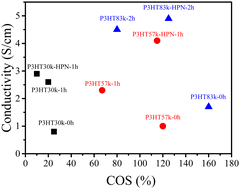The role of the commercial nucleating agent HPN-68L in the stretchable and electrical properties of solvent vapor annealed P3HT†
Abstract
Crystallinity, molecular order and tie chains are crucial factors in determining the mechanical and electrical properties of semiconducting polymers. 1,2-Dichlorobenzene (ODCB) vapor annealing increases the crystallinity and molecular order but decreases the number of tie chains in poly(3-hexylthiophene) (P3HT), leading to an increase in its conductivity but a decrease in its crack onset strain (COS). In this work, the commercial nucleating agent bicyclo[2.2.1]heptane-2,3-dicarboxylic acid disodium salt (HPN-68L) was shown to be capable of nucleating P3HT with different molecular weights. The addition of HPN-68L increases the number of nucleation sites in P3HT and accelerates P3HT crystallization, effectively bridging the crystals and increasing the number of tie chains in middle and high molecular weight P3HT films. After the same ODCB vapor annealing time, the P3HT-HPN film (with HPN-68L) has high crystallinity and a large number of tie chains, leading to conductivity higher than that of an annealed P3HT film (without HPN-68L), and an excellent COS, similar to that of an as-cast P3HT film but superior to that of an annealed P3HT film. For P3HT above a certain molecular weight, the addition of a nucleating agent is a novel and effective method for improving its conductivity without significantly reducing its COS when the P3HT film is annealed by a solvent vapor, which solves the difficult problem of the low toughness of the annealed P3HT film.



 Please wait while we load your content...
Please wait while we load your content...